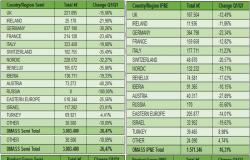Add
Article added
Download the PDF
According to the latest growth projections from the International Monetary Fund – and assuming that the Union retains its 27 members – China is expected to exceed the European Union’s share of global GDP by 2025.
- The IMF estimates that the Union only represents 17.41% of the wealth produced in the world this year, compared to 30.96% in 2004 — a year marked by enlargement to 10 new countries.
- Since the financial crisis of 2008, the European Union’s share of global GDP has continued to decline, with an acceleration starting with the Covid pandemic in 2020.
- Japan is also following a similar trend, although its decline began earlier, in the mid-1990s. The country then represented 17.75% of world GDP, compared to 3.77% today.
In purchasing power parity, the European dropout is part of a longer dynamic that dates back at least to the 1980s. By erasing the weight provided to American GDP thanks to the strength of the dollar, the United States is following a similar trajectory to that of the Union. The emerging powers, China and India in the lead, are experiencing constant progress.
- This “European decline” was recently highlighted in the report by Enrico Letta presented to the heads of state and government of the Union last week. Emmanuel Macron subsequently took it up during his speech at the Sorbonne on Thursday April 25.
- Among other things, two elements make it possible to explain the gap in wealth per person which has continued to widen between Europeans and Americans since the 1970s: better demographic growth as well as energy sovereignty which results in net exports of hydrocarbons.
In order to compensate for the decline of European countries in the world economy, the French president declared that he wanted to push for the making of “massive” strategic decisions: produce more – in particular products with high added value -, accelerate the deployment of a policy European industrial sector, invest in strategic sectors (AI, semiconductors, quantum, etc.) and reduce agricultural, energy and resource dependencies on the United States and China.






